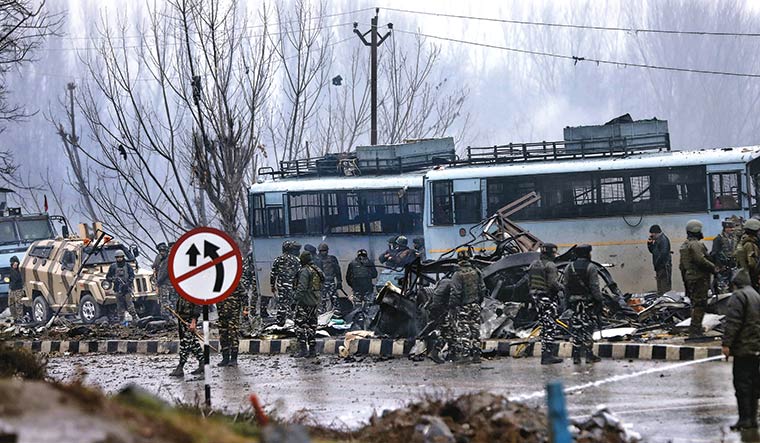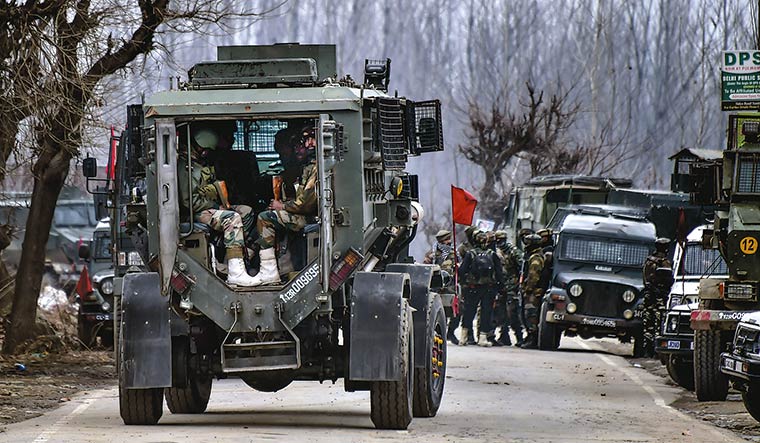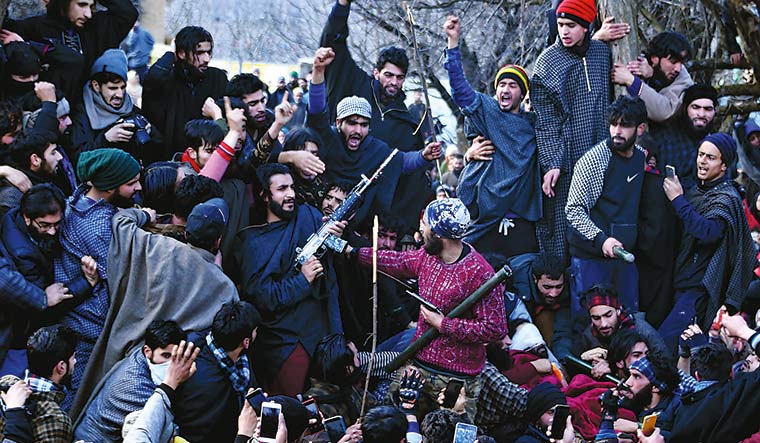Sukhjit Kaur of Moga in Punjab is bereaved. But she also feels she is lucky.
Her husband, Havildar Jaimal Singh, was one of 2,547 Central Reserve Police Force personnel who began a fateful journey from Jammu to Srinagar at 3.30pm on February 14. A Jaish-e-Mohammad fidayeen driving a vehicle laden with explosives ensured that their 78-vehicle convoy was brutally halted.
“I am lucky that I received the body of my husband,” said Sukhjit. “His was the only body that was intact, except that he had lost one arm and his face was burnt because of the blast. So many other bodies were unrecognisable. Many families got just mortal remains.”
The explosion, which shook Lethpora village in Jammu and Kashmir’s Pulwama district, left 40 men dead and many injured. Blood and body parts, mixed with dust and rubble and ash, marked the blast site.
Something had gone terribly wrong that afternoon. Sukhjit is looking for answers, and so are India’s security brass. How could a single suicide bomber inflict such horror on a region guarded by more than a lakh troopers from the Army, the CRPF, the Border Security Force and sundry other agencies?
Unlike what was initially believed, the blast was not triggered by the impact from the bomber ramming his vehicle into the fifth bus in the convoy. Bomb-disposal experts who scanned the site said a lot of sophisticated planning had gone into assembling the improvised explosive device (IED) that ripped through the convoy. Preliminary findings of the National Bomb Data Centre, which functions under the elite National Security Guard, have revealed that the IED had a switch that triggered the explosion.
The report, details of which were accessed by THE WEEK, says the explosives weighed between 80kg and 135kg. It was a mix of RDX and ammonium nitrate—a potent combination intended to inflict maximum damage.
Despite initial concerns of the Army, the government had made the NSG part of the counterinsurgency grid in Jammu and Kashmir last year. “A USP of the NSG is post-blast investigations,” said NSG director-general Sudeep Lakhtakia. “We have an active bomb data centre that has experts who can detect IEDs, dispose bombs and counter IED attacks.”
On the day of the attack, NSG commandos were in the Border Security Force camp near the Srinagar airport. Less than three hours after the emergency call from Delhi came through, they were scanning the blast site for clues. “The storage, the container and [the way] the vehicle-borne IED [was loaded] bear signs of a professional job,” said a top security official. “It is difficult for a group like the Jaish to have all the expertise and wherewithal to do this within the valley. It points to a larger conspiracy involving more sophisticated players.”
Lt Gen (retd) D.S. Hooda, who oversaw the 2016 surgical strikes across the Line of Control, said RDX was a military-grade explosive that was hard to obtain. “The recovery of RDX seems to have established a military hand in the attack,” he said. “It is a known fact that the Jaish and the ISI (Pakistan’s Inter-Services Intelligence) are in bed. It means that a lot of training has gone into the attack. There are military experts who train terrorists in camps across the border.”
This takes us to the first question: How was such a large quantity of RDX obtained and assembled?
According to officers of the National Investigation Agency, who reached the blast site a day after the attack, this is where the first intelligence failure seems to have occurred. The NIA, which registered the case related to the blast on February 20, is investigating the route and the source of the explosives.
The explosives could have been smuggled from Pakistan into Kashmir. Intelligence officials said 130 infiltrations had taken place along the LoC last year, while unofficial estimates put the figure around 200. Official data reveals that there are now around 80 active JeM members in the valley. The NIA is inquiring into whether RDX and other incendiary material were also smuggled from across the border.
“Terror outfits like Jaish have possibly been smuggling in incendiary material along with the infiltrating fidayeen and foot-soldiers,” said K. Srinivasan, a senior officer who served in the intelligence wings of the BSF and the CRPF. “It is possible that this material was assembled with the help of local car mechanics. It was also stored somewhere and transported in containers, before being assembled inside the vehicle. But it went undetected. There was no pin-pointed input on any such activity.”
For now, intelligence agencies are clueless about the bomb-makers, transporters, RDX smugglers and the car mechanics who might have been part of the larger conspiracy.
While the vehicle-borne IED attack at Lethpora has been termed a “rare” occurrence, militants have been using bombs and IEDs to target the security forces. Last year alone, there were eight IED attacks on Army convoys. This year, too, several intelligence warnings about such attacks had been issued.
The first such warning of a JeM attack, shared with state police forces, was issued on January 26. According to the alert, a JeM operative called Muhammad Ibrahim, known as both Ismail and Lamba, had reportedly been camping near Delhi. He was directed to return to Pakistan because of an “operational exigency”. “He is likely to travel to the Jammu sector, and from there, JeM cadres will arrange his safe passage to Sialkot in Pakistan. Earlier, he was in the valley alongside [JeM operative] Muhammad Umar due to a change in their operational plan,” said the alert.
Another intelligence input shared with all Central and state police forces said “a group of four Pakistan-based fidayeen are likely to cross over to India from the Narot Jaimal Singh border area in Pathankot district in Punjab, with an intention to carry out a terror activity.”
The alert also referred to a pro-JeM channel on Telegram, a messaging platform. The channel, Ansar-e-Jaish, had enabled the circulation of an audio clip of JeM founder Masood Azhar, in which he claimed that their mujahideen were present in Jammu and Kashmir, Lucknow, Delhi and Mumbai.
Another intelligence input said the JeM had “directed its JK-based cadres to proceed to Delhi for planning and executing a terrorist action, possibly a fidayeen attack”. This alert also referred to Hasan Wani, an operative of the banned Ansar Ghazwat-ul-Hind, who had been tasked to train recruits in Delhi in handling grenades. He was arrested in Jammu on August 4 last year with eight grenades. Wani hailed from Pulwama.
The last in the string of warnings came on February 8, a day before the sixth anniversary of the hanging of Muhammad Afzal Guru, who was convicted for masterminding the 2001 attack on Parliament. “It is not as if there is any dearth of intelligence,” said a security officer posted in Kashmir. “In fact, there are too many intelligence alerts. Some of them are generic in nature, which is why all inputs are not acted upon and a slip-up happens.”
There is also a multiplicity of agencies in the valley, and operating procedures sometimes prompt each agency to guard its turf as well as its source. “The J&K police collects the maximum intelligence and acts as a feeder agency to the Army and other security forces,” said an Army officer in the valley. “Then there is the Intelligence Bureau, which actively collates and analyses inputs. But there is no centralised system, where the Army or a force like the CRPF can access these inputs.”
For want of a centralised system, the officers on ground spend time establishing their own contacts and finding their own sources across agencies. The rigid hierarchy and information channels do not give them much room for manoeuvre. “There are two ways of intelligence gathering,” said a senior intelligence officer in Kashmir. “One is to pay the source. And the other is to have a rapport with people who would come and give you information.”
The first way has its drawbacks. The source could give you wrong information or sell half-truths. The other way of intelligence gathering depends on a mix of factors, like the local people’s rapport with the security forces. In Kashmir, this second option often determines the success or failure of an operation. The Pulwama attack was an intelligence failure, but the special forces operation that killed the person who allegedly masterminded the attack, a Pakistani national called Kamran, was an intel-based success.
“If the local people—like a car mechanic or a fruit seller—are happy and comfortable, they would give us tip-offs about suspicious movements of men or material, spot unfamiliar faces, and even warn the security forces of a particular terrain. But, when they are unhappy, and feel alienated and resentful, they would simply look the other way. Silence on the ground is dangerous,” said the senior intelligence officer.
It does not help that the state has been under president’s rule. “In J&K, whenever there is Central rule, there is tension that grows into aggression against the security forces,” said a security official. That the cadres of regional political parties turn unhelpful only aggravates the problem.
On February 14, before he made his fateful journey, Jaimal Singh was at a transit camp in Jammu. All troops travelling from Jammu to Srinagar are supposed to report to the Jammu camp, which can accommodate about 1,000 personnel at a time. That day, there were 5,000 troops waiting to go to Srinagar.
According to a CRPF report, troops often get stranded in Jammu because of delayed or irregular troop movements. Buses are used for transits because the number of waiting troops are often high. But the buses, according to the CRPF’s own assessment, have thin metallic plates that cannot protect its men from bullets or IEDs.
Since there is always a threat of troops being fired upon, a few vehicles are fitted with bullet-resistant plating. But there is no safety measures that offer protection from IEDs. Troops are provided additional bullet-proof vehicles only after they reach Qazikund in Anantnag district.
The convoy Jaimal was part of was so large because the Jammu-Srinagar highway had been closed because of heavy snowfall. Apparently, it was a “pile-up” of convoys that could not leave the camp for three days. The previous such pile-up had resulted in 91 vehicles carrying 2,871 troops leaving Jammu for Srinagar on February 4.
“The threat to convoys in the valley has traditionally been from standoff firing and from IEDs planted conventionally, for which adequate security measures have been devised and implemented. Troops have been trained to deal with it,” said a CRPF officer.
A ‘road-opening party’, members of which include personnel from the Army and the CRPF, is tasked with clearing the road of IEDs. It is only after the party gives the green light that a convoy carrying troops starts moving. The Army guards the vulnerable points along the corridor through which the convoy passes.
The blast on February 14 showed that the whole procedure is unsafe. It also left few clues for the investigators, who are combing through the burnt wreckage to piece together what happened.
Among the deceased was CRPF constable Subramanian G. of Tuticorin in Tamil Nadu. Subramanian had joined the force a year and a half earlier, and was on the front lines when stone-pelting had gripped the valley. “My brother had stitches on his head for five months,” said his brother Krishnaswamy. “When he came on leave, we asked him what had happened. He told us only that he had to perform his duty. He never shared anything with us. But we were always worried for him.”
In Punjab, Sukhjit is coping with equally painful memories. “My husband was a generous man. He could never say no to anyone. He was not supposed to go out of Jammu, but he decided to help his friend, who wanted to go on leave for a family function. He was to replace his friend in Srinagar,” she said.
Jaimal had joined the CRPF in 1993 as a driver. He left a desk job in Jammu, managing vehicles, to go to Srinagar. He, too, was looking forward to going home soon. Jaimal’s five-year-old son, who was born 10 years after his marriage, had begun to speak full sentences. “Today, he is telling everyone how his papa has returned home in a box and how his last rites have been performed,” said Sukhjit. “His father had taken us to the Golden Temple recently. It was our last drive together.”




